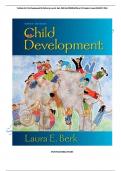Test Bank for Child Development 9th Edition by Laura E. Berk, ISBN No;9780205149766, all 15 Chapters Covered (NEWEST 2024)
STUDYGUIDESOLUTIONS
, Test Bank for Child Development 9th Edition by Laura E. Berk, ISBN No;9780205149766, all 15 Chapters Covered (NEWEST 2024)
Test Bank for Child Development 9th Edition by Laura E. Berk
Table of Contents
Part I: Theory and Research in Child Development
Chapter 1 History, Theory, and Applied Directions
Chapter 2 Research Strategies
Part II: Foundations of Development
Chapter 3 Biological Foundations, Prenatal Development, and Birth
Chapter 4 Infancy: Early Learning, Motor Skills, and Perceptual Capacities
Chapter 5 Physical Growth
Part III: Cognitive and Language Development
Chapter 6 Cognitive Development: Piagetian, Core Knowledge, and Vygotskian
Perspectives
Chapter 7 Cognitive Development: An Information-Processing Perspective
Chapter 8 Intelligence
Chapter 9 Language Development
Part IV: Personality and Social Development
Chapter 10 Emotional Development
Chapter 11 Self and Social Understanding
Chapter 12 Moral Development
Chapter 13 Development of Sex Differences and Gender Roles
Part V: Contexts for Development
Chapter 14 The Family
Chapter 15 Peers, Media, and Schooling
STUDYGUIDESOLUTIONS
, Test Bank for Child Development 9th Edition by Laura E. Berk, ISBN No;9780205149766, all 15 Chapters Covered (NEWEST 2024)
CHAPTER 1
HISTORY, THEORY, AND APPLIED DIRECTIONSMULTIPLE
CHOICE
1) The field of child development
A) is devoted to understanding human constancy and change throughout the lifespan.
B) is part of a larger, interdisciplinary field known as developmental science.
C) focuses primarily on physical and emotional development.
D) focuses primarily on and social and cognitive development.Answer: B
Page Ref: 4
2) The common goal of investigators who study child development is to
A) understand how physical growth and nutrition contribute to health and well-being throughout the lifespan.
B) understand more about personality and social development.
C) analyze child-rearing practices and experiences that promote well-being.
D) describe and identify those factors that influence the consistencies and changes in young people during thefirst two decades of life.
Answer: D
Page Ref: 4
3) Which of the following factors contributed to the study of child development in the twentieth century?
A) The beginning of public education led to a demand for knowledge about what and how to teach children ofdifferent ages.
B) Parents were having more children and researchers became interested in the effects of family size on well-being.
C) Pediatricians were pressured by insurance companies to improve health, which inspired nutritionalresearch.
D) High rates of childhood depression inspired new areas of research into anxieties and behaviorproblems.
Answer: A
Page Ref: 4
4) Which of the following statements is true about the field of child development?
A) Scientific curiosity is the prevailing factor that led to the study of children, and current researchers primarilyanswer questions of scientific
interest.
B) The field of child development is considered interdisciplinary because it has grown through the combinedefforts of people from many
fields.
C) Child development is the area of study devoted to understanding constancy and change throughout thelifespan.
D) Most of what we know about child development comes from psychologists and medical professionals.Answer: B
Page Ref: 4
5) Development is often divided into which of the following three broad domains?
A) infancy, childhood, and adolescence
B) social, cultural, and historical
C) physical, cognitive, and emotional and social
D) biological, social, and intellectualAnswer: C
Page Ref: 4
STUDYGUIDESOLUTIONS
, Test Bank for Child Development 9th Edition by Laura E. Berk, ISBN No;9780205149766, all 15 Chapters Covered (NEWEST 2024)
6) The domains of development
A) combine in an integrated, holistic fashion.
B) are not influenced by each other.
C) operate independently of one another.
D) are distinct and unrelated.
Answer: A
Page Ref: 4
7) What period of human development brings the most rapid time of change?
A) the prenatal period
B) infancy and toddlerhood
C) early childhood
D) adolescence
Answer: A Page
Ref: 5
8) During which period of development do children form their first intimate ties to others?
A) the prenatal period
B) infancy and toddlerhood
C) early childhood
D) middle childhood
Answer: B
Page Ref: 5
9) Charlotte is long and lean. She engages in make-believe play and has a blossoming sense of morality.Charlotte is probably in which
period of human development?
A) the prenatal period
B) infancy and toddlerhood
C) early childhood
D) middle childhood
Answer: C
Page Ref: 5 6
10) Pete participates in soccer and is beginning to master fundamental reading and math skills. Pete isprobably in which period of
human development?
A) adolescence
B) middle childhood
C) early childhood
D) infancy and toddlerhood
Answer: B
Page Ref: 6
11) During adolescence,
A) thought and language expand at an astounding rate.
B) young people begin to master academic knowledge and skills.
C) young people fully assume adult roles.
D) thought becomes abstract and idealistic.Answer: D
Page Ref: 6
STUDYGUIDESOLUTIONS





